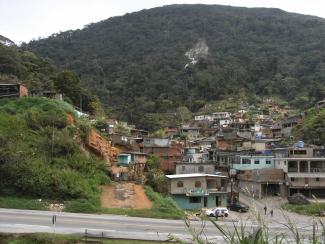Ecosystems
Protecting the environment

Extreme weather and natural disasters are becoming ever more common in all parts of the world. Experts say this trend will continue. The effects tend to be drastic. Extreme weather events like heavy rainfall, tornadoes or hurricanes are creating new high-risk areas. In regions that are already at risk, living conditions are worsening for local communities.
The poorest and most vulnerable people are often those who have no other choice but to live in high-risk areas. The global population is growing, and in densely-settled regions, people, industries and agriculture are competing for land. Poor people are often forced to live in unsafe areas, and they normally lack the money and technical expertise to protect themselves.
Many natural ecosystems, such as species-rich forests, are being destroyed to make room for arable land, pastures or housing. The same ecosystems, however, provide natural protection for humans. For instance, forests on hills prevent landslides and floods. The roots stabilise slopes and absorb large volumes of water during rainstorms.
Brazil’s southern and southeastern states are particularly affected by increasingly frequent extreme weather. The mountain region of the State of Rio de Janeiro is particularly vulnerable because of its topography, geology and the human-caused destruction of the Atlantic coast’s forests.
In January 2011, unusually long and heavy rainfall led to numerous landslides and widespread flooding in the town of Teresópolis. Over 900 people died within a few hours, and over 45,000 residents lost their homes. This natural disaster was the worst the region has ever experienced, but smaller catastrophes occur regularly, claiming many people’s lives every year.
The potential of ecosystem services
In order to reduce the risk that extreme weather events pose, Brazil has thus far relied primarily on “grey” engineering and infrastructure projects, such as building protective walls or channelling rivers. In contrast, those responsible for reducing the impact of natural disasters have paid little attention to “green” measures that would minimise risks. Such measures include the reforestation of degraded ecosystems in order to allow them to serve their protective function once more.
Intact ecosystems also perform other functions, known as "ecosystem services". They help to regulate the climate, preserve biodiversity, protect the soil and water and nutrient cycles. Green risk reduction not only protects against natural disasters, it also preserves the environment and contributes to stabilising the climate in general.
In contrast to grey measures, however, green risk reduction depends on long-term policy commitments. Existing ecosystems have to be constantly protected from destruction through resource exploitation or illegal settlements. On the other hand, it takes time for damaged ecosystems to recover.
Accordingly, green measures cannot succeed unless they are supported by the local people in the long run. Residents have to be involved in projects and contribute to their implementation. That is true of both conservation and reforestation.
The Brazilian government recently seems to be taking a greater interest in green measures, which are also referred to as “ecosystem-based adaptation” (EbA). Brazil’s Ministry for the Environment and the German Agency for International Cooperation (GIZ) commissioned the Berlin-based Centre for Rural Development (SLE) to conduct studies on the devastated municipality of Teresópolis. The SLE team coordinated by Wolfram Lange did research on how the residents themselves perceive environmental risks and how well informed they are. On this basis, the SLE published a list of recommendations on how to sensitize, inform and involve the local population.
Success made possible by participation
In order for ecosystem-based measures to succeed, the local people have to be prepared to take an active role. Those who are planning measures should therefore inform residents of their intentions and raise awareness for the project. The Community based Approach (CbA) depends on the knowledge, needs and priorities of the people directly concerned. Moreover, knowledge should not be conveyed in a top-down fashion, but rather communicated in regard to the needs of local communities.
CbA stipulates that four basic conditions must be met for people to participate actively in the protection and restoration of ecosystems:
- First, people have to be aware of the risk. Otherwise they will not see any need to protect themselves.
- Second, they have to understand the connection between natural disasters and ecosystems. It must be clear that the degradation of ecosystems increases risks, whereas an intact environment can lessen the impact of extreme weather. The implication is that people must learn how ecosystems reduce risk as well as how they can be protected and restored.
- Third, it is crucial that people assume responsibility. Conservation in particular will only work if everyone participates over the long term. Their acceptance of schemes is thus indispensable.
- Fourth, people must recognise what opportunities for action they have, so motivated citizens can actually achieve goals.
Risk reduction in Teresópolis
The SLE conducted an analysis in Teresópolis, assessing residents’ knowledge and awareness in regard to these four points. According to this analysis, the first condition for active citizen participation is already fulfilled in Teresópolis. The people are quite aware of their vulnerability. In the light of the tragedy of 2011, this is hardly surprising. Almost every resident knows at least one family who was affected. In addition, over two thirds of the residents have the impression that rainstorms have become stronger and more frequent in the past decade.
The residents also understand that intact ecosystems are essential and thus recognise the importance of environmental protection. However, the majority of the people know little about how exactly intact ecosystems reduce the risks of natural disasters.
Most residents of Teresópolis believe that both the citizens and the state are responsible for conservation. But if they are asked about specific measures, it becomes clear that they limit their own responsibility to appropriate rubbish disposal. Only a few feel any responsibility for restoring degraded ecosystems. Most people think that it is the government’s duty.
Nevertheless, the citizens’ sense of accountability provides good opportunities to involve them in ecosystem-based measures. Many are simply unaware of how they, as individuals or as members of a community, can make a difference. Many people feel that they do not have enough money or time to do so. They don’t understand that even in the normal course of their lives, they can change their behaviour in ways that will benefit the environment and ultimately reduce their own vulnerability. For example, they could do a „Mutirão“, a community activity: At a Mutirão, the village community gathers on a Sunday to plant trees on plain field. Together they can replant an entire mountain slope in one afternoon.
In order to promote ecosystem-based measures in Teresópolis, the Brazilian government should focus on two things:
- It has to deliver practical knowledge about the role local ecosystems play in risk reduction, and
- it has to show citizens what they themselves can do.
The government should spell out tangible options and what they would cost. It should also make an effort to give the people accurate and differentiated information concerning the risks. The reason is that people do not automatically draw the right conclusions even if they realise that they are extremely vulnerable.
One goal must be to enable residents to tell the difference between places where ecosystem-based measures offer a safe, inexpensive and sensible opportunity to reduce risks and places that are so exposed to harm that people should move away. Only on this basis will they be able to make the right choices.
Ecosystem-based measures are a sustainable way to reduce environmental risks. Moreover, reforestation and forest protection contribute meaningfully to adapting to climate change. Policy-makers must design measures sensibly and involve the local community in planning and implementation. Successful projects are likely to become models for other regions of the world.
Lea Dünow conducted research in Teresópolis on behalf of the Berlin-based Centre for Rural Development (SLE). She is currently working for AMBERO Consulting.
lea.duenow@gmail.com
Christian Pirzer contributed to the same SLE research project for the SLE. He is currently working for the development consultancy Endeva.
pirzer.c@gmail.com
Anja Schelchen also conducted to the SLE project. She is currently working for the Centre for Rural Development. All three authors would like to thank Leandro Cavalcante, Rodrigo Medeiros, Yara Valverde and the students from the Universidade Federal Rural do Rio de Janeiro (UFRRJ), who all contributed to the study.
anja_schelchen@hotmail.de







